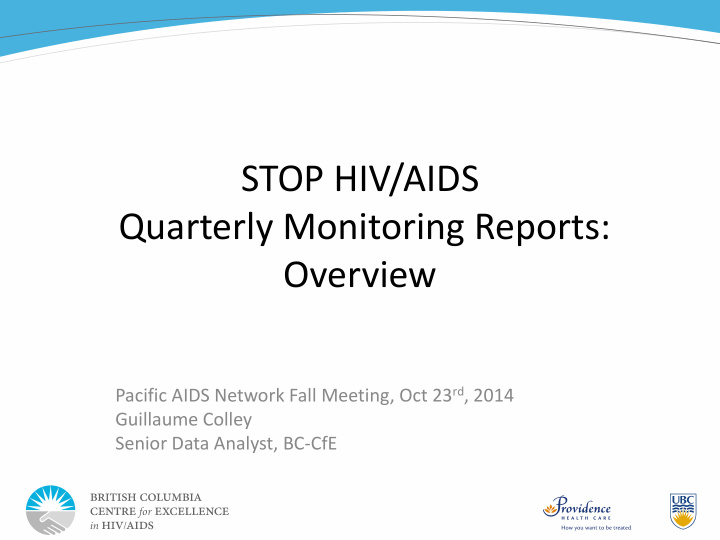



STOP HIV/AIDS Quarterly Monitoring Reports: Overview Pacific AIDS Network Fall Meeting, Oct 23 rd , 2014 Guillaume Colley Senior Data Analyst, BC-CfE
Introduction • Efficacy of HIV Treatment as Prevention (TasP) depends on overcoming numerous barriers: – Financial and structural to access testing, care and treatment – Patient and provider-level barriers – Institutional barriers • Longitudinal monitoring of TasP program is essential to optimize individual and public health outcomes Lourenço et al., JAIDS 2014
Report creation process • Collaborative approach • Interdisciplinary team • 13 indicators were chosen • 1 report for the province + 1 report for each Health Authority • Reports released quarterly, with a data lag of 6 weeks • Available publicly on the BC CfE and the STOP HIV/AIDS websites
Indicators: overview • 1. Testing Episodes Testing and Diagnosis • 2. HIV Testing Rate • 3. New HIV Diagnoses • 4. Stage of HIV Infection at Diagnosis • 5. HIV Cascade of Care Treatment and Care • 6. Programmatic Compliance Score (PCS) • 7. New Antiretroviral Starts • 8. CD4 Cell Count at ART Initiation • 9. Active and Inactive Drug Treatment Program Participants • 10. Antiretroviral Adherence Level Resistance and Outcomes • 11. Resistance Testing Results by Resistance Category • 12. AIDS-Defining Illness • 13. HIV-Related Mortality Where appropriate, indicators are stratified by subgroups of interest, including HIV risk group and demographic characteristics.
Indicators: data sources • British Columbia Center for Disease Control database (Testing, Diagnosis, AIDS cases) • Sunquest Laboratory database at the Provincial Public Health Microbiology and Reference Laboratory (Testing, Diagnosis) • Providence Health Care Laboratory (pVL, CD4, resistance) • BC CfE Drug Treatment Program Database (ARV treatment) • BC Vital Statistics database (Mortality) • Limitations: see STOP HIV/AIDS Quarterly Monitoring Technical Report
Indicator 1: Testing Episodes • Provided by BCCDC • POC tests are available only after 2010 Q4 • Overall and stratified by – Gender – Age – HA, HSDA
Indicator 2: Testing Rates • Provided by BCCDC • Overall and stratified by – Gender – Age – HA, HSDA
Indicator 3: New HIV Diagnoses • Provided by BCCDC • Overall and stratified by – Gender – Age – Exposure Category – HA, HSDA
Indicator 4: Stage of HIV Infection at Diagnosis • Provided by BCCDC • Overall and stratified by – Gender – Age – Exposure Category
Indicator 5: HIV Cascade of Care • Overall and stratified by – Gender – Age – MSM status – IDU status – MSM by Age Category – HA, HSDA • Estimates are used to complete Indicator 5 (Linkage and Retention stages of the Cascade) as the fully linked STOP cohort is not timely enough to allow current reporting
Indicator 6: Programmatic Compliance Score (PCS) Reference: Lima VD, Le A, Nosyk B, Barrios R, Yip B, et al. (2012) Development and Validation of a Composite Programmatic Assessment Tool for HIV Therapy. PLoS ONE 7(11): e47859.
Indicator 7,8,9: ARV Uptake
Indicator 7,8,9: ARV Uptake
Indicator 10: ARV Adherence
Indicator 11: Resistance Testing and Results
Indicator 12: AIDS Defining Illness
Indicator 13: HIV-Related Mortality
Documentation • Reports: http://www.cfenet.ubc.ca/publications/centre-documents/stop- hivaids-monitoring-reports • Technical Report: http://stophivaids.ca/STOP/wp-content/uploads/ME- Technical-Report-Complete_V4_25Nov2013.pdf • Published article by Lourenço et al: Process Monitoring of an HIV Treatment as Prevention Program in British Columbia, Canada. THANK YOU
Recommend
More recommend